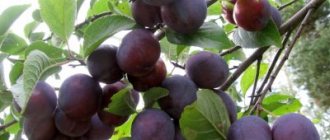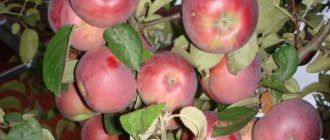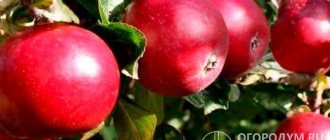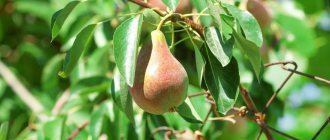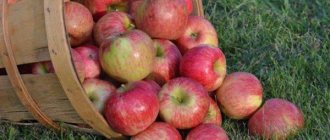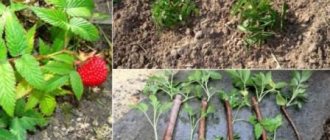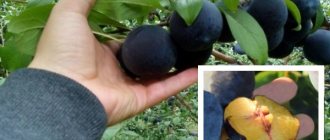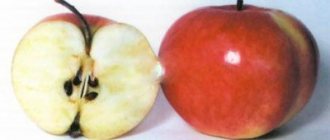Description of the berry crop
For clarity, below are the most important information about the Jamovaya sea buckthorn variety with photos.
General idea of the variety
Jemova bushes grow no more than 2.5 m, and the erect shoots do not have thorns - all this contributes to quick and safe harvesting. The dark green leaf blades are medium in size and slightly concave in the middle. The rounded crown of the bush is medium dense.
Berries
The Jamovaya variety is valued primarily for the excellent taste characteristics of the fruit - the sweet and sour berries received a tasting score of 4.4 points out of 5 possible. The variety belongs to large-fruited sea buckthorn: the weight of the berry is 0.8-0.9 g. The shape is oval, elongated. Due to the bright orange-red color of the Jamovaya berries, it looks very decorative during fruiting.
How does pollination occur?
It is preferable to plant one female plant and two male plants. This is due to the fact that the latter very often die, and moreover, a pair of plants provides better pollination of female seedlings. Therefore, the gardener has many chances to harvest a harvest that has excellent taste. Male plants are planted near each other at a distance of less than 100 cm. However, there is also self-pollinating sea buckthorn.
In addition to the above varieties, there are also the following:
- Aley;
- Chechek;
- Tenga;
- Solar;
- Dwarf;
- Thornless;
- Vorobievskaya;
- Sudarushka;
- Etna;
- Pearl mussel;
- Sweet;
- Amateur;
- Present.
Among such an amazing variety, every gardener can easily find a variety that is right for him.
Characteristic
The description of sea buckthorn Jamovaya is presented in detailed varietal characteristics given below.
Main advantages
Jam is distinguished by high levels of drought and frost resistance (its shoots do not freeze up to -35 0C). Like most other varieties of sea buckthorn, it is unpretentious in care - with proper planting and minimal care it produces consistently high yields. When preparing a planting site for Jemova, you should take into account the type of soil - the variety grows well on any soil, except heavy and acidic.
Flowering period and ripening time
Female Jam Sea Buckthorn trees bloom in early to mid-May, producing yellowish flowers without fragrance. The ripening period of the variety is average, so the fruits can be harvested in early autumn. Since climatic conditions are different in different regions of the country, these dates can be considered conditional.
Yield indicators, fruiting dates
The sea buckthorn variety Jamovaya is considered very productive and produces about 12 kg of fruit from one bush. After planting, the sea buckthorn bush bears fruit in the 4th year.
Important! Maximum productivity can be achieved only with the presence of a male pollinator, the best of which are the varieties Ural, Gnome, Dear Friend, Adam, Alei, and timely competent care.
Area of application of berries
The dessert taste characteristics of sea buckthorn berries of the Dzhemovaya variety allow them to be widely used in processing and preparing preparations for the winter: juices, jams. The fruits are suitable for freezing.
Resistance to diseases and pests
The variety has good resistance to possible diseases and pests, with the exception of the sea buckthorn fly - this insect most often affects Jemova bushes.
Advantages and disadvantages of the variety
The Jamovaya variety has a lot of positive characteristics, thanks to which it has gained great popularity among Russian summer residents. Among them are:
- low stature of the bush;
- absence of thorns;
- excellent frost resistance;
- large fruit;
- sufficient stalk length;
- dessert taste characteristics of berries.
This sea buckthorn has several significant disadvantages, for example, semi-dry detachment of berries and frequent infestation by the sea buckthorn fly.
Features of sea buckthorn “Jam”
Varietal shrubs are bred by breeders so that they are maximally adapted to the requirements of summer residents and can bring real benefits. Sea buckthorn with the appetizing name “Jam” has many advantages, and the berry is useful, like an elixir, which can overcome more than one ailment.
- low-growing shrub - up to 2.5 meters, which is very convenient for harvesting;
- it does not have sharp thorns, which are unloved by all summer residents;
- the berry has an orange-red color, the shape of the fruit is elongated;
- semi-dry tear-off variety;
- sea buckthorn “Jamovaya” has a dessert purpose;
- taste according to experts is 4.4 points out of 5 possible;
- frost-resistant sea buckthorn. It can partially freeze out only in very rare cases. Productivity, accordingly, will decrease in such a year;
- diseases and pests are not terrible for the variety. It is extremely rare that the sea buckthorn fly can bother you; resistance to it is relative;
- taste – sweet and sour, pleasant;
- high-yielding variety - one bush can produce up to 12 kg of sea buckthorn, the fruits weigh up to 1 gram;
- has a medium-late ripening period;
- A pollinator variety is required.
Let’s talk separately about the last item in the list-description of the sea buckthorn variety “Jamovaya”. If the tree is not pollinated, then it may bear fruit, but this does not happen every year, not in all regions, and the quality of the harvest is not very good. Therefore, if you plant a female sea buckthorn seedling, then somewhere nearby a male bush should grow in the direction of the wind flow. It is advisable that there are no obstacles in the form of outbuildings in the way.
It is easy to distinguish male and female seedlings - the former have larger buds, they are covered with scales that consist of several cells, while the latter are smaller in size, with only two scales. Choose seedlings correctly, it is better to do this in a nursery, they will tell you exactly which varieties are male and which are female. You can take cuttings from shrubs that grow somewhere nearby; they inherit the characteristics of the “parent”. And if we talk about sea buckthorn, it is better to buy seedlings that are at least 2-3 years old.
On a note! Pollinators that are suitable for the sea buckthorn variety “Jamovaya” are “Adam”, “Aley”, “Ural”, “Dear Friend”, “Gnome”. These are male varieties.
It is also worth noting that the fruits contain a lot of useful substances: vitamins - A, E, K, P, C, B1 and B2, minerals - nickel, magnesium, calcium, potassium, manganese, sodium, strontium, iron, phosphorus, acids – wine, lemon, coffee, apple. It is also a source of essential oils, carotenoids, and fiber. Calorie content in 100 grams of berries is 82 kcal.
Landing rules
In order for the sea buckthorn bush of the Jamovaya variety to take root, it is necessary to properly plant it in a permanent place.
Recommended timing
Planting a Jemovaya bush depends on the presence of an earthen lump on the roots: if it is absent, then sea buckthorn is planted in early spring, as soon as the ground thaws, in late March - early April. For autumn planting, seedlings with a closed root system are suitable; then planting takes place at least a month before the onset of stable frosts.
Choosing a suitable location
When choosing a landing site for Jemova, you need to take into account several important requirements:
- Placing sea buckthorn on a site involves planting two seedlings - a male and a female.
- The sea buckthorn bush bears fruit well only in sunny, well-lit areas, so there should be no shading (you should not plant sea buckthorn next to tall crops).
- The root system of sea buckthorn is powerful and spreading, so near groundwater it can freeze due to temperature changes. Also, due to the characteristics of the root system, Jamovaya should be planted separately; proximity to any crops is undesirable.
- In order for pollination to occur efficiently and pollen to fall on the pistils of the female plant, when planting a male specimen, the direction of the wind is taken into account.
Soil preparation
To plant a young annual Jemova bush, it is enough to dig a hole 50 × 50 cm and fill it with a nutrient mixture. Drainage is placed at the bottom, for example, river sand, a bucket of organic matter (compost, humus), mineral fertilizers, for example, 200 g of superphosphate, are poured on top, and sprinkled with a loose top layer of soil until a flat surface is formed.
Selection and preparation of seedlings
Plants that have no signs of diseases or pests take root well, so it is important to inspect the bushes in detail before planting. If it is possible to assess the condition of the root system, then you should pay attention to its development - the seedling should have 4-6 skeletal roots. The optimal height of the above-ground part is about 20 cm.
Important! When planting in spring, the seedling can be soaked in water for a couple of hours, if the root looks dried out; when planting in autumn, all foliage is removed from the plant.
Algorithm and landing scheme
The optimal planting pattern for sea buckthorn is 3 × 2.5 m, but the distance can be increased. The seedlings are placed in the prepared holes, straightening the roots (with the root system open). It is recommended to plant grafted sea buckthorn on a small mound so that when watering, the grafting site does not end up in the ground. Self-rooted sea buckthorns can be buried - they will send out additional roots.
Important! The support must be placed before planting sea buckthorn.
Agricultural technology for growing sea buckthorn. Variety "Jam"
Requirements for place and soil
Sea buckthorn is a very unpretentious shrub, but still it may not produce a good harvest or even die in one area or another. The shrub is very sensitive to close-flowing groundwater and lowlands where water accumulates in the spring. Temperature changes inside such a swamp lead to the fact that the roots begin to rot, rot, and gradually the sea buckthorn dies. Therefore, an important condition is moderately moist soil and plenty of sunlight.
It is also worth noting that you do not need to plant shrubs where you are digging a vegetable garden or flower beds, since the root system spreads greatly to the sides and you can injure it. Remember that you will have to plant two varieties at once for pollination, and the male one in the direction from which the wind will blow it so that the pollen can fly. As for the soil, sea buckthorn “Jamovaya” grows well on chernozems, sandy and loamy soils. Heavy soils that do not allow air to pass through harm the roots; good drainage is required here.
On a note! Regarding soil acidity, it is best to plant shrubs where the pH level is 6.5-7. That is, on slightly alkaline or neutral soil.
Site preparation and planting
So, you have found an area where there will be plenty of space for the roots, where there is an opportunity to plant another variety nearby, there is a lot of sun for the crown, and there are no tall trees. The last condition is also important, since sea buckthorn in the shade may wither and not produce a good harvest. The optimal time is spring so that the seedling has time to take root. Now you need to dig a hole - 50/50 cm or a little less, put a sand substrate in it for drainage and add a bucket of compost or rotted manure, superphosphate - 200 grams.
Then place the seedling in the hole, just below the level at which it grew in the pot, to form additional roots. You dig a hole, compact the soil, and water it. Now you need to trim the side branches, leaving only the central trunk. You can mulch the soil to retain moisture and heat.
Advice! If you have very little space on your site to plant two types of sea buckthorn at once, then you can graft 2-3 branches of a male tree onto a female one. This is often practiced by experienced summer residents.
Further care
After planting, you need to mow seedlings of sea buckthorn “Jamovaya” and the pollinator variety for the first month so that they take root faster. But we remember that in swampy, wet soil, roots can be prohibited. Therefore, everything is good in moderation; after watering, loosening is necessary. Once sea buckthorn has taken root, it will only need moisture on dry days. Fertilizer is applied once a season, and any organic fertilizer is best. There is no need for excess, the bush does not like it.
Subsequent care of the crop
Growing Jam sea buckthorn does not cause difficulties even for novice gardeners.
Necessary activities
Caring for sea buckthorn includes the operations below:
- Watering. After planting the Jemova seedling, monitor the soil moisture and water it so that it does not dry out. After the bush adapts to new conditions and takes root, watering is reduced and not carried out at all, with the exception of especially hot days.
- Feeding. Jam is undemanding to soil fertility. In the first year of planting, you don’t have to feed it at all if the bush was planted in fertilized soil. Already fruit-bearing adult specimens need to be fertilized - in the spring they are fed with nitrogen-containing fertilizers, and in the summer and autumn - with phosphorus-potassium fertilizers.
- Processing the tree trunk circle: weeding and loosening. To limit the growth of weeds, prevent the formation of a dry crust on the surface and retain moisture in the soil, it is recommended to mulch the tree trunk circle of the bush.
Shrub pruning
The Jemovaya bush is characterized by weak growth and a not too thick crown, so it does not need to be formed. Pruning sea buckthorn is undesirable, as the crop does not tolerate it well. Autumn sanitary pruning of the bush into a ring is recommended - removing diseased and dead branches in order to prevent the occurrence of diseases.
Advice! You should only use clean garden tools for pruning. After the event, it also needs to be disinfected.
Preparing for winter
Since the Jamovaya variety is characterized by high winter hardiness, there is no need to cover the bush for the winter in its adult state. In the first year of planting, it is advisable to mulch the tree trunk circle so that the root system does not freeze. Autumn activities include adding fertilizers containing potassium and phosphorus to the soil.
Diseases and pests
For clarity, possible diseases and pests of sea buckthorn variety Dzhemovaya are collected in tables indicating preventive and treatment measures.
Table 1 - Pests
| Pest | Preventive measures | Control measures |
| Sea buckthorn fly | Mulching the tree trunk circle with a layer of 15 cm makes it difficult for the pest to escape from the soil in the spring | Chemicals: Intavir, Iskra, Fitoverm. Folk remedies: digging up the soil in late autumn, treating with tansy infusion |
| Sea buckthorn moth | Spring spraying during bud break with a solution of biological preparations (“Entobacterin”, etc.) | Treatment with chlorophos (0.4%) during bud break, metaphos (0.3%) during budding |
| Sea buckthorn aphid, gall mite | Timely removal of weeds and plant debris | Chemicals: Intavir, Kleschevit. Folk remedies: repellent infusions of tobacco, onion peels or garlic, potato and tomato tops |
Table 2 - Common diseases
| Disease | Signs of the disease | Control measures |
| Fusarium wilt | Swelling and redness form on the bark of the shoots, the leaves turn yellow and wither, the fruits are painted in a varietal shade, but do not fill out | Carrying out sanitary pruning to ensure air permeability of the bush, followed by destruction of the pruned shoots (burning). |
| Scab | Black ulcers and spots on the bark and leaves of mainly young branches, as well as fruits | At the end of the season, the affected parts of the bush are pruned, and in the spring they are treated with Bordeaux mixture of 1% concentration |
| Endomycosis | The fruits become covered with light spots and burst, and slimy grayish pulp flows out of the berry shell. | Timely removal of affected fruits along with the branch. After flowering and during fruit filling, spray with Bordeaux mixture of 1% concentration |
Diseases and pests most often affect weakened plants, the basic care requirements for which are not met. In order for the Jamovaya sea buckthorn bushes to remain healthy and bear fruit successfully, it is necessary to pay special attention to fertilizing, pruning, weeding and loosening.
